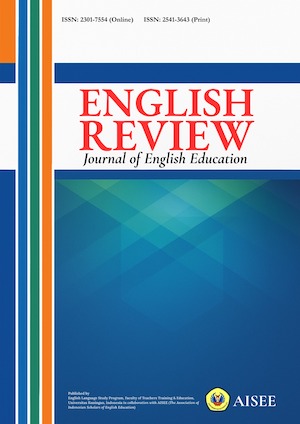A SEMIOTIC ANALYSIS OF JERIENG TRIBE'S SEDEKAH GUNUNG TRADITION
Abstract
Myth is a story whose origin and author are unknown. The purpose of a Myth is to explain natural processes, the creation of the world, human races, traditional customs, political institutions, or religious rituals. In Pelangas Village, West Bangka, there is a tribe known as the Jerieng Tribe. This tribe has a tradition that is still practiced by its people, which the Sedekah Gunung tradition. This tradition is carried out every year to coincide with the 14th night full moon. Because the Sedekah Gunung ritual tradition is a traditional procession that cannot be separated from people's belief in myth, this research aims to analyze the representation of myth in the Sedekah Gunung ritual using semiotic theory by Charles Sanders Peirce. This research uses descriptive qualitative methods with data collection techniques in the form of a combination of interviews, observation, documentation. The results of this research found several ritual practices in Sedekah Gunung which symbolize the Jerieng Tribe's belief in the sacredness of the Sedekah Gunung ritual, belief in the myth of the symbiotic relationship between humans and nature through the practice of giving and receiving, as well as the respect and communication of the Jerieng Tribe towards nature through Sedekah Gunung.All articles published in English Review: Journal of English Education (ERJEE) are licensed under the Creative Commons Attribution 4.0 International License (CC BY 4.0).
Copyright Ownership
Authors retain the copyright of their articles and grant ERJEE the right of first publication. The journal is granted a non-exclusive license to publish, reproduce, and distribute the article in any format, medium, or platform, provided that proper credit is given to the original authors.
License Terms – CC BY 4.0
Under the Creative Commons Attribution 4.0 International License, others are free to:
- Share — copy and redistribute the material in any medium or format
- Adapt — remix, transform, and build upon the material for any purpose, even commercially
As long as they:
- Provide appropriate credit to the original author(s) and source
- Provide a link to the license (https://creativecommons.org/licenses/by/4.0/)
- Indicate if any changes were made
There are no restrictions on the reuse, reproduction, or adaptation of published articles as long as attribution is properly given.
Author Warranties
By submitting a manuscript to ERJEE, authors confirm that:
- The work is original and does not infringe any existing copyright.
- The manuscript has not been previously published and is not under consideration elsewhere.
- All sources and references are appropriately acknowledged.
- Necessary permissions have been obtained for any copyrighted materials used.









